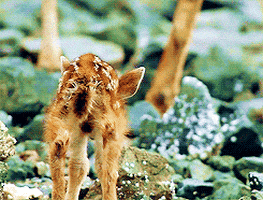Stop! Leave Bambi Alone!
We don’t need another hero; we don’t need to know the way home…Thunderdome lyrics
It’s that time of year, and as you gaze out into your backyard... Wait, what? You spot a lone fawn nestled in the grass. Instantly, the Disney trauma kicks in, and you envision that Bambi’s mother has been tragically killed. But hold on! While we've all been scarred by that iconic movie scene, remember: such scenarios are rare. As Tina Turner famously sang in Thunderdome, "We don't need another hero." You are not Bambi’s mother, so leave that fawn alone and let nature take its course. Bambi is just fine and isn’t as alone as you might think.
Newborn Fawns are Virtually Scentless
You spot a lone fawn nestled in the grass. Instantly, the Disney trauma kicks in, and you envision Bambi’s mother has been tragically killed.
As the seasons change and nature transitions, you might find yourself looking out into your backyard or taking a walk in the woods, only to spot a lone fawn nestled in the grass or standing quietly by itself. Your first instinct may be to worry that this adorable creature has been abandoned, but rest assured, Bambi is not alone—nature is simply taking its course.
Understanding Fawn Behavior
During this time of year, it’s common to see young deer, or fawns, without their mothers. Unlike many animals that keep their young close at all times, a doe will often leave her fawn hidden in a safe spot while she goes off to forage for food. This behavior is a natural survival strategy.
Newborn fawns are virtually scentless, which helps protect them from predators. Their spotted coats provide excellent camouflage among the dappled sunlight of the forest floor. By staying still and quiet, they blend seamlessly into their surroundings, making them hard to detect.
Why You Should Let Nature Take Its Course
When you come across a fawn alone, your first reaction might be to intervene, thinking that it needs help. However, the best thing you can do is to leave it undisturbed. The mother is likely nearby, and she will return to nurse and care for her baby when it’s safe. Human interference can do more harm than good, potentially leading the mother to abandon her fawn if she perceives too much threat or disruption.
What to Do If You Find a Fawn
Observe from a Distance: Keep your distance and observe the fawn quietly. Avoid approaching or touching it, as human scent and presence can attract predators.
Don’t Attempt to Move It: Fawns are safest where their mothers have hidden them. Moving a fawn can disorient it and make it more vulnerable.
Be Patient: Understand that this is a temporary situation. The doe will return several times a day to check on and feed her fawn.
Contact Wildlife Professionals If Necessary: If the fawn appears injured, or if you are certain that its mother has been killed (e.g., you’ve seen the deceased doe), contact a local wildlife rehabilitator for advice.
Fair Use Disclaimer: This post includes references to copyrighted material used for commentary, education, and criticism under fair use. All rights to the original works remain with their respective owners.
Embracing Nature’s Rhythms
Witnessing a fawn on its own is a beautiful reminder of the rhythms of nature. It’s a moment to appreciate the ingenuity and resilience of wildlife. By respecting these natural processes, we allow the delicate balance of the ecosystem to thrive.
Leave Bambi Alone
The doe will return, and the cycle of life will continue…
So next time you look out and see Bambi by himself, take a deep breath, enjoy the serene scene, and trust that nature knows what it’s doing. The doe will return, and the cycle of life will continue, just as it has for generations.






